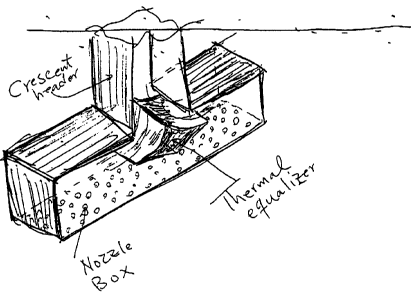Note : Les descriptions sont présentées dans la langue officielle dans laquelle elles ont été soumises.
CA 02300839 2000-03-17
THERMAL EQUALIZER
Field of the Invention
This invention relates to paper web drying and in particular to the profiling
of
air in the drying process.
Background of the Invention
Yankee type hoods are among the main elements in paper web drying
processes and a Yankee hood is an air distribution and drying system, which
operates
at high temperatures. Typically, a Yankee hood is shaped to be installed over
a
portion of the circumferential surface of a rotatable cylinder. The air has
been heated
I 0 and pressurized in the system is then supplied to the dryer where it
passes through
nozzles at high velocity and impinges on the moving, drying web. The spent air
is
collected in the dryer and returned to a recirculation system. Some of this
spent air is
exhausted, but the majority of it is recirculated to conserve heat.
The heat which is transferred from the impingement air from the nozzles to the
1 S paper is used to increase the temperature of the paper to its equilibrium
drying
temperature, evaporates the water from the paper, and increases the
temperature of the
paper above the equilibrium temperature after the surface water has been
evaporated.
Increasing production rates result in the demand for higher and higher
evaporation rates. Achieving evaporation rates considerably higher than those
CA 02300839 2000-03-17
currently will be realized largely through improvements to the Yankee hood
system.
In a Yankee hood, the evaporation is driven largely by convection heat
transfer,
brought upon by the effect of impinging jets of hot air and radiation heat
transfer.
Effectiveness of hood evaporation largely depends on geometry of impingement
air,
properties of impingement air, and temperature.
Uneven cross-machine direction temperature profiles that are directly related
to the heat transfer or drying rate, are a major problem on many paper
machines.
Temperature profile problems can originate at the crescent header and nozzle
box.
This is pronounced more at higher operating temperature. Temperature profile
problems can be caused in the dryer section by uneven condensate removal,
uneven
cross-machine direction moisture profile and uneven air distribution in the
supply or
exhaust. It can result in operational and quality problems including reel
building,
corrugated rolls, converting difficulties, and rejected papers. Many mills
overdry the
sheet to compensate for moisture profile problems. This results in higher
energy
consumption and reduced production.
The present invention addresses the problem of thermal non-uniformity in the
drying section of the hood by providing a combination of elements that results
in a
uniform temperature and uniform nozzle velocity in the cross-machine
direction. This
means that by having the thermal equalizer and a divider plate in the nozzle
boxes
uniform thermal profiles at certain distances in cross-machine direction are
obtainable.
According to a broad aspect, the present invention relates to a thermal
equalizer for use in a paper web drying machine of the type including nozzle
boxes
fed by crescent headers, said equalizer being located substantially in said
nozzle box
adjacent the junction thereof with said crescent head and comprising a
distorted
diamond-shaped configuration having upper and lower sloped surfaces for
applying
direction and uniformity to the flow of air into and out of said nozzle box.
-2-
CA 02300839 2000-03-17
Description of the Drawings
The invention is illustrated by way of example in the accompanying drawings
in which:
FIGURE 1 is a schematic cross-section showing air flow into the nozzle box
and around the equalizer; and
FIGURE 2 is a perspective view of the invention.
The thermal equalizer, see Figure 1, will work in high temperature operating
conditions as well as in low temperature operating conditions. The upper part
of the
device is designed to turn the air with low loss. The radius of the vanes
varies
depending on the fluid dynamic condition and the geometry of the crescent
header and
nozzle box. The lower part of the device is sloped to keep the uniform jet
velocity.
Thermal equalizer reduces the heat exchange between the supply air and the
nozzle box face; reduces the velocity pressure and increases the static
pressure in the
nozzle box; it mixes the supply air with cold boundary layer in the nozzle box
and
gives a uniform temperature even across the nozzle box. The combination of
these
effects, gives a uniform air jet velocity and a uniform temperature just after
the nozzle
box.
While the invention has been described in connection with a specific
embodiment thereof and in a specific use, various modifications thereof will
occur to
those skilled in the art without departing from the spirit and scope of the
invention as
set forth in the appended claims.
The terms and expressions which have been employed in this specification are
used as terms of description and not of limitations, and there is no intention
in the use
of such terms and expressions to exclude any equivalents of the features shown
and
described or portions thereof, but it is recognized that various modifications
are
possible within the scope of the invention claims.
-3-
